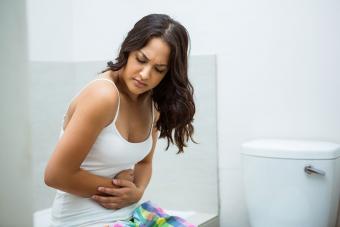
Do you get uncomfortable twinges each month in your belly area? If so, it might be related to your monthly cycle. Ovulation pain, or mittelschmerz, is lower abdominal pain that occurs on one side at or around the time an egg is released from the ovary.
Up to 40% of people with ovaries experience pain around the time of ovulation. Some will experience pain every month, which can range from mild to severe. Others will only experience ovulation pain occasionally. While there is not much you can do to prevent the discomfort, knowing more about it might help to put your mind at ease.
What Ovulation Pain Feels Like
The timing of the onset of ovulation pain varies from person to person, and even from month to month. Someone may feel before ovulation pain, during, or after ovulation. The pain usually goes away after 3 to 12 hours, although some people may experience persistent ovulation pain until their period begins.
For many people, ovulation pain feels like a dull ache. The discomfort may occur right before ovulation, as the follicle swells and stretches the ovary before the egg is released. Other people feel a sudden sharp pain that lasts just for a moment. This may be the moment of ovulation when the mature egg bursts out of the follicle and makes its way down the fallopian tube. In addition to abdominal pain, cramping, and pinching, some people feel mild back pain during mittelschmerz.
Ovulation pain is often mild, but it can also range in intensity and be so severe that it sends people to the emergency room (ER) because the pain is so overwhelming. In some cases may be mistaken for appendicitis.
You may notice that you tend to feel ovulation pain only on one side. Some people tend to feel ovulation out of one ovary more than others. This is completely normal. Contrary to popular belief, ovaries do not "take turns" ovulating every month. Some people ovulate more from one ovary than the other during their reproductive years, according to the Cleveland Clinic.
What Causes Ovulation Pain?
While there are wives' tales regarding the causes of ovulation pain, we've learned more over the years about what is happening at this stage in your cycle. Medical experts have identified several factors that contribute to ovulation pain, including:
- A follicle that swells with an egg, stretching the surface of the ovary
- The follicle then ruptures, releasing a mature egg from the ovary
- Fluid and/or blood is released from the ruptured egg follicle, which may irritate the abdominal lining
- Endometriosis affecting the ovaries or other pelvic organs can exacerbate ovulation pain
- Scar tissue in the pelvic area from previous sexually transmitted infections or pelvic/abdominal surgery can worsen ovulation pain and increase the duration of time it is felt
Ovulation Pain and Fertility
If you are trying to identify the peak of your fertile window to get pregnant or to avoid pregnancy, mittelschmerz may be a useful sign of fertility but is not the best way to predict when ovulation occurs. Other ovulation tracking methods can more accurately predict exactly when you will ovulate:
- Change in basal temperature
- Change in cervical mucus or fluid
- Change in cervical position or firmness
- A positive result on an ovulation predictor test
- Breast tenderness
- Increased sex drive
If you are actively trying to conceive, it is important to learn, understand, and become aware of your body, the signs and symptoms that occur during your fertile window, and the changes that occur within your body around the time of ovulation.
If you consistently experience ovulation pain, you may want to track this each month during your menstrual cycle. This can help you identify your peak fertile days. If you experience ovulation pain in addition to other signs of fertility, you may conceive during this time.
It is unclear exactly when an egg is released after ovulation pain. But, once a mature egg is released from the ovary it lives for only 12 to 24 hours. If you had sex three to five days leading up to ovulation, you have a higher chance of conceiving, since sperm can live up to 5 days in the female reproductive tract.
How to Manage Ovulation Pain
Ovulation pain usually isn't a cause for concern. Medical sources suggest that ovulation pain or menstrual pain in general can be relieved by using a heating pad or taking over-the-counter pain medications, such as acetaminophen or ibuprofen.
If your ovulation pain is severe, talk to your healthcare provider. They may check for signs of a more serious condition, such as pelvic inflammatory disease, or ovarian cysts. See your healthcare provider if you have ovulation pain and other symptoms, such as:
- Dizziness or lightheadedness
- Fever
- Heavy bleeding
- Nausea
- Ongoing, severe pain that affects your quality of life
- Vomiting
Lastly, remember that ovulation pain is completely normal in most cases. You can even use these signals from your body to enhance fertility or avoid pregnancy (along with more effective contraceptive measures). If your discomfort becomes unmanageable, don't be afraid to reach out for help. You and your healthcare provider can troubleshoot the issue to come up with the best treatment.







